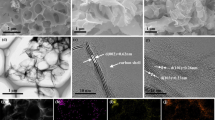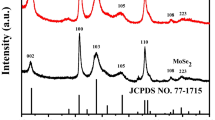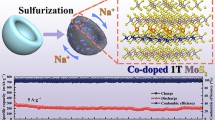Abstract
The scalable synthesis of MoS2/N-doped carbon (MoS2/NC) nanosheets was accomplished using a facile salt template–assisted synthesis method. The MoS2 nanosheets were uniformly encapsulated in nitrogen-doped carbon frameworks. As an anode for sodium-ion batteries (SIBs), the electrochemical performance of the MoS2/NC electrode was significantly improved compared to pure MoS2, which demonstrated a reversible capacity of 334.6 mAh g−1 after 100 cycles at 0.2 A g−1; even after 250 cycles of 1 A g−1, the capacity could still be maintained at 252.9 mAh g−1. This excellent sodium storage performance was mainly due to the coupling of nitrogen-doped carbon with MoS2 and the uniform distribution of the nanosheets, which improved the reaction kinetics. Besides, the electrochemical reconstruction ensured the integrity of the electrode. This work was of great significance for the large-scale synthesis of MoS2 anode material with enhanced stability SIBs.








Similar content being viewed by others
Data availability
The data presented in this paper are available on request from the corresponding author.
References
Yang X, Rogach AL (2020) Anodes and sodium-free cathodes in sodium ion batteries. Adv Energy Mater 10(22):2000288. https://doi.org/10.1002/aenm.202000288
Yabuuchi N, Kubota K, Dahbi M et al (2014) Research development on sodium-ion batteries. Chem Rev 114(23):11636–11682. https://doi.org/10.1021/cr500192f
Liu Y, Wu X, Moeez A et al (2022) Na-rich Na3V2(PO4)3 cathodes for long cycling rechargeable sodium full cells. Adv Energy Mater 13(3):2203283. https://doi.org/10.1002/aenm.202203283
Feng W, Zhu L, Dong X et al (2022) Enhanced moisture stability of lithium-rich antiperovskites for sustainable all-solid-state lithium batteries. Adv Mater 25:636–643. https://doi.org/10.1002/adma.202210365
Wang Y, Qu Q, Li G et al (2016) 3D Interconnected and multiwalled carbon@MoS2@carbon hollow nanocables as outstanding anodes for Na-ion batteries. Small 12(43):6033–6041. https://doi.org/10.1002/smll.201602268
Sun N, Guan Z, Liu Y et al (2019) Extended “adsorption–insertion” model: a new insight into the sodium storage mechanism of hard carbons. Adv Energy Mater 9(32):1901351. https://doi.org/10.1002/aenm.201901351
Cui J, Yao S, Kim J (2016) Recent progress in rational design of anode materials for high-performance Na-ion batteries. Energy Storage Mater 7:64–114. https://doi.org/10.1016/j.ensm.2016.12.005
Yang C, Xiang Q, Li X et al (2020) MoO3 nanoplates: a high-capacity and long-life anode material for sodium-ion batteries. Journal of Materials Scienc 55:12053–12064. https://doi.org/10.1007/s10853-020-04788-z
Li R, Qing L, Zhao W et al (2022) Co3O4/nitrogen-doped carbon nanoparticles for high-performance Li/Na-ion batteries. Ionics 28:2613–2622. https://doi.org/10.1007/s11581-021-04424-z
Xiao Y, Lee S, Sun Y (2016) The application of metal sulfides in sodium ion batteries. Adv Energy Mater 7(3):1601329. https://doi.org/10.1002/aenm.201601329
Yuan J, Qu B, Zhang Q et al (2020) Ion reservoir enabled by hierarchical bimetallic sulfides nanocages toward highly effective sodium storage. Small 16(31):1907261. https://doi.org/10.1002/smll.201907261
Wang H, Jiang H, Hu Y et al (2017) 2D MoS2/polyaniline heterostructures with enlarged interlayer spacing for superior lithium and sodium storage. J Mater Chem A 5:5383–5389. https://doi.org/10.1039/C7TA00030H
Yang L, Wang S, Mao J et al (2012) Hierarchical MoS2/polyaniline nanowires with excellent electrochemical performance for lithium-ion batteries. Adv Mater 25(8):1180–1184. https://doi.org/10.1002/adma.201203999
Hui Z, Hu L, Gong S et al (2021) Flower-petal-like Nb2C MXene combined with MoS2 as bifunctional catalysts towards enhanced lithium-sulfur batteries and hydrogen evolution. Electrochim Acta 404(1):139781. https://doi.org/10.1016/j.electacta.2021.139781
Wu J, Liu J, Cui J et al (2020) Dual-phase MoS2 as a high-performance sodium-ion battery anode. J Mater Chem A 8:2114–2122. https://doi.org/10.1039/C9TA11913B
Zhou S, Liu S, Chen W et al (2021) A “biconcave-alleviated” strategy to construct Aspergillus niger-derived carbon/MoS2 for ultrastable sodium ion storage. ACS Nan 15(8):13814–13825. https://doi.org/10.1021/acsnano.1c05590
Feng M, Zhang M, Zhang H et al (2019) Room-temperature carbon coating on MoS2/graphene hybrids with carbon dioxide for enhanced sodium storage. Carbon 153:217–224. https://doi.org/10.1016/j.carbon.2019.07.021
Tao H, Li J, Li J et al (2021) Metallic phase W0.9Mo0.1S2 for high-performance anode of sodium ion batteries through suppressing the dissolution of polysulfides. J Energy Chem 66:356–365. https://doi.org/10.1016/j.jechem.2021.08.026
Zhang R, Li H, Sun D et al (2018) Facile preparation of robust porous MoS2/C nanosheet networks as anode material for sodium ion batteries. J Mater Sci 54:2472–2482. https://doi.org/10.1007/s10853-018-2991-z
Cui L, Tan C, Li Y et al (2021) Hierarchical Fe2O3@MoS2/C nanorods as anode materials for sodium ion batteries with high cycle stability. ACS Appl Energy Mater 4(4):3757–3765. https://doi.org/10.1021/acsaem.1c00167
Xue F, Fan F, Zhu Z et al (2023) MoS2/CoS heterostructures grown on carbon cloth as free-standing anodes for high-performance sodium-ion batteries. Nanoscale 15:6822–6829. https://doi.org/10.1039/D3NR00866E
Li J, Luo SH, Ding X et al (2018) NaCl-template assisted synthesis of 3D honeycomb-like LiMnPO4/C with high rate and stable performance as lithium-ion battery cathodes. ACS Sustain Chem Eng 6(12):16683–16691. https://doi.org/10.1021/acssuschemeng.8b03935
Tang WJ, Wang XL, Xie D et al (2018) Hollow metallic 1T MoS2 arrays grown on carbon cloth: a freestanding electrode for sodium ion batteries. J Mater Chem A 6:18318–18324. https://doi.org/10.1039/C8TA06905K
Li X, Yang Y, Liu J et al (2017) MoS2/cotton-derived carbon fibers with enhanced cyclic performance for sodium-ion batteries. Appl Surf Sci 413:169–174. https://doi.org/10.1016/j.apsusc.2017.03.259
Li H, Yu G, Luo J et al (2022) Soft-template-assisted synthesis of petals-like MoS2 nanosheets covered with N-doped carbon for long cycle-life sodium-ion battery anode. J Electroanal Chem 922:116715. https://doi.org/10.1016/j.jelechem.2022.116715
Li J, Gao W, Huang L et al (2021) In situ formation of few-layered MoS2@N-doped carbon network as high performance anode materials for sodium-ion batteries. Appl Surf Sci 571:151307. https://doi.org/10.1016/j.apsusc.2021.151307
Liu G, Cui J, Luo R et al (2019) 2D MoS2 grown on biomass-based hollow carbon fibers for energy storage. Appl Surf Sci 469:854–863. https://doi.org/10.1016/j.apsusc.2018.11.067
Sun D, Ye D, Liu P et al (2017) MoS2/graphene nanosheets from commercial bulky MoS2 and graphite as anode materials for high rate sodium-ion batteries. Adv Energy Mater 8(10):1702383. https://doi.org/10.1002/aenm.201702383
Kandula S, Shrestha KR, Kim NH et al (2018) Fabrication of a 3D hierarchical sandwich Co9S8/α-MnS@N-C@MoS2 nanowire architectures as advanced electrode material for high performance hybrid supercapacitors. Small 14(23):1800291. https://doi.org/10.1002/smll.201800291
Guruprasad K, Maiyalagan T, Shanmugam S (2019) Phosphorus doped MoS2 nanosheet promoted with nitrogen, sulfur dual doped reduced graphene oxide as an effective electrocatalyst for hydrogen evolution reaction. ACS Appl Energy Mater 2(9):6184–6194. https://doi.org/10.1021/acsaem.9b00629
Wang Z, Chen T, Chen W et al (2012) CTAB-assisted synthesis of single-layer MoS2-graphene composites as anode materials of Li-ion batteries. J Mater Chem A 1(6):2202–2210. https://doi.org/10.1039/C2TA00598K
Shan TT, Xin S, You Y et al (2016) Combining nitrogen-doped graphene sheets and MoS2: a unique film-foam-film structure for enhanced lithium storage. Angew Chem Int Ed 55(41):12783–12788. https://doi.org/10.1002/anie.201606870
Sun W, Hu Z, Wang C et al (2016) Effects of carbon content on the electrochemical performances of MoS2-C nanocomposites for Li-ion batteries. ACS Appl Mater Interfaces 8(34):22168–22174. https://doi.org/10.1021/acsami.6b05594
Yuan Z, Wang L, Li D et al (2021) Carbon-reinforced Nb2CTx MXene/MoS2 nanosheets as a superior rate and high-capacity anode for sodium-ion batteries. ACS Nano 15(4):7439–7450. https://doi.org/10.1021/acsnano.1c00849
Mei Y, Li TT, Qing J et al (2020) Construction of a C@MoS2@C sandwiched heterostructure for accelerating the pH-universal hydrogen evolution reaction. Chem Commun 56:13393–13396. https://doi.org/10.1039/D0CC06049F
Jeong SY, Park SK, Kang YC et al (2018) One-dimensional nanostructure comprising MoSe2 nanosheets and carbon with uniformly defined nanovoids as an anode for high-performance sodium-ion batteries. Chem Eng J 56:13393–13396. https://doi.org/10.1016/j.cej.2018.06.130
Qiu H, Zheng H, Jin Y et al (2020) Dopamine-derived N-doped carbon-encapsulated MoS2 microspheres as a high-performance anode for sodium-ion batteries. Ionics 26:5543–5551. https://doi.org/10.1007/s11581-020-03734-y
Pan Q, Zhang Q, Zhang F et al (2018) Construction of MoS2/C hierarchical tubular heterostructures for high-performance sodium ion batteries. ACS Nano 12(12):12578–12586. https://doi.org/10.1021/acsnano.8b07172
Wu J, Pan Z, Zhang Y et al (2018) The recent progress of nitrogen-doped carbon nanomaterials for electrochemical batteries. J Mater Chem A 6(27):12932–12944. https://doi.org/10.1039/C8TA03968B
Maulana AY, Song J, Futalan CM et al (2022) Improved reversibility of phase transformations using electron-rich graphitic carbon matrix in FeF2 cathode for sodium-ion batteries. Chem Eng J 434:134727. https://doi.org/10.1016/j.cej.2022.134727
Chen B, Lu H, Zhou J et al (2018) Porous MoS2/carbon spheres anchored on 3D interconnected multiwall carbon nanotube networks for ultrafast Na storage. Adv Energy Mater 8(15):1702909. https://doi.org/10.1002/aenm.201702909
Hai S, Shen X, Ting M et al (2017) Reversible conversion of MoS2 upon sodium extraction. Nano Energy 41:217–224. https://doi.org/10.1016/j.nanoen.2017.09.039
Liu P, Cai S, Zuo Y et al (2021) Synthesis of interlayer expanded MoS2 by sulfurization of MoO3 with enhanced sodium-ion storage. J Alloys Compds 895:162691. https://doi.org/10.1016/j.jallcom.2021.162691
Zhang X, Shi H, Liu L et al (2021) Construction of MoS2/Mxene heterostructure on stress-modulated kapok fiber for high-rate sodium-ion batteries. J Colloid Interface Sci 605:472–482. https://doi.org/10.1016/j.jcis.2021.07.097
Li J, Ding Z, Pan L et al (2021) Facile self-templating synthesis of layered carbon with N, S dual doping for highly efficient sodium storage. Carbon 173:31–40. https://doi.org/10.1016/j.carbon.2020.10.092
Li J, Ding Z, Li J et al (2020) Synergistic coupling of NiS1.03 nanoparticle with S-doped reduced graphene oxide for enhanced lithium and sodium storage. Chem Eng J 407:127199. https://doi.org/10.1016/j.cej.2020.127199
Yuan Z, Cao J, Valerii S et al (2021) MXene-Bonded hollow MoS2/carbon sphere strategy for high-performance flexible sodium ion storage. Chem Eng J 430:132755. https://doi.org/10.1016/j.cej.2021.132755
Jing L, Lian G, Niu F et al (2018) Few-atomic-layered hollow nanospheres constructed from alternate intercalation of carbon and MoS2 monolayers for sodium and lithium storage. Nano Energy 51:546–555. https://doi.org/10.1016/j.nanoen.2018.06.084
Ge M, Rong J, Fang X et al (2012) Porous doped silicon nanowires for lithium ion battery anode with long cycle life. Nano Lett 12(5):2318–2323. https://doi.org/10.1021/nl300206e
Wu C, Ou JZ, He F et al (2019) Three-dimensional MoS2/carbon sandwiched architecture for boosted lithium storage capability. Nano Energy 65:104061. https://doi.org/10.1016/j.nanoen.2019.104061
Lu Y, Zhao Q, Zhang N et al (2015) Facile spraying synthesis and high-performance sodium storage of mesoporous MoS2/C microspheres. Adv Func Mater 26(6):911–918. https://doi.org/10.1002/adfm.201504062
Hu X, Chen J, Zeng G et al (2017) Robust 3D macroporous structures with SnS nanoparticles decorating nitrogen-doped carbon nanosheet networks for high performance sodium-ion batteries. J Mater Chem A 5(45):23460–23470. https://doi.org/10.1039/C7TA08169C
Li Y, Kong LB, Liu MC et al (2017) Facile synthesis of Co3V2O8 nanoparticle arrays on Ni foam as binder-free electrode with improved lithium storage properties. Ceram Int 43(1):1166–1173. https://doi.org/10.1039/C7TA02616A
Cho JS, Park JS, Jeon KM et al (2017) 1-D nanostructure comprising porous Fe2O3/Se composite nanorods with numerous nanovoids, and their electrochemical properties for use in lithium-ion batteries. J Mater Chem A 5(21):10632–10639. https://doi.org/10.1039/C7TA02616A
Chen Z, Wu R, Liu M et al (2017) General synthesis of dual carbon-confined metal sulfides quantum dots toward high-performance anodes for sodium-ion batteries. Adv Funct Mater 27(38):1702046. https://doi.org/10.1002/adfm.201702046
Tu F, Han Y, Du Y et al (2018) Hierarchical nanospheres constructed by ultrathin MoS2 nanosheets braced on nitrogen-doped carbon polyhedra for efficient lithium and sodium storage. ACS Appl Mater Interfaces 11(2):2112–2119. https://doi.org/10.1021/acsami.8b19662
Bai X, Li D, Zhang D et al (2023) Boosting high-rate lithium storage in Li3VO4 via a honeycomb structure design and electrochemical reconstruction. J Mater Chem A 11(23):12164–12175. https://doi.org/10.1039/D3TA01817B
Funding
The work was supported by the Natural Science Foundation of Chongqing Science and Technology Bureau (Grant No. CSTB2022NSCQ-MSX0244 and cstc2022ycjh-bgzxm0037), the Science and Technology Research Program of Chongqing Municipal Education Commission (Grant No. KJZD-K202001402 and FLKJ,2022CBZ4059), and the Science and Technology Research Program of Chongqing Municipal Education Commission (Grant No. KJQN202101422).
Author information
Authors and Affiliations
Contributions
Fang-Xiao Du performed the research and wrote the manuscript; Song-Li Liu, Yang Li, Jian-Kang Wang, and Peng Zhang all analyzed the data and were involved in the revision of the manuscript. All authors reviewed the manuscript.
Corresponding author
Ethics declarations
Ethics approval
This work did not include any studies involving humans or animals.
Competing interests
The authors declare no competing interests.
Additional information
Publisher’s Note
Springer Nature remains neutral with regard to jurisdictional claims in published maps and institutional affiliations.
Supplementary Information
Below is the link to the electronic supplementary material.
Rights and permissions
Springer Nature or its licensor (e.g. a society or other partner) holds exclusive rights to this article under a publishing agreement with the author(s) or other rightsholder(s); author self-archiving of the accepted manuscript version of this article is solely governed by the terms of such publishing agreement and applicable law.
About this article
Cite this article
Du, FX., Liu, SL., Li, Y. et al. Facile synthesis of MoS2/N-doped carbon as an anode for enhanced sodium-ion storage performance. Ionics 29, 5183–5193 (2023). https://doi.org/10.1007/s11581-023-05212-7
Received:
Revised:
Accepted:
Published:
Issue Date:
DOI: https://doi.org/10.1007/s11581-023-05212-7




